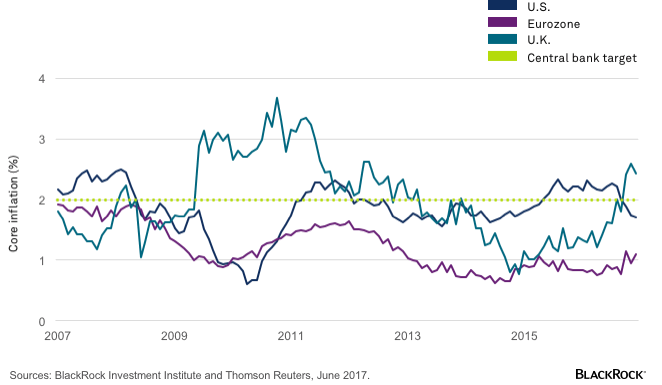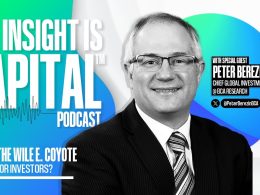by Isabelle Mateos y Lago, Chief Multi-Asset Strategist, Blackrock
One year on from the Brexit referendum, Isabelle explains why the Bank of England is facing a different problem than other major developed market central banks.
For all the recent talk of major central banks coordinating to telegraph policy shifts, it’s easy to forget that each institution faces very different challenges. The Federal Reserve (Fed), the European Central Bank (ECB) and the Bank of Japan have all expressed confidence that they are making progress towards achieving their mandates despite inflation losing steam and remaining well below target for most. The Fed has a clear path for lifting interest rates and shrinking its $4.5 trillion balance sheet, sticking to a view that this year’s inflation setback is probably temporary. The ECB is mulling policy adjustments—most likely by reducing bond purchases—as the expansion powers on, but has stressed the need for prudence and gradualism to foster an inflation recovery. In stark contrast, the Bank of England (BoE) is confronted with an economy where growth is slowing at the same time that inflation is overshooting its 2% target.
A little more than a year after the Brexit referendum, UK economic data are sending mixed messages. UK first-quarter gross domestic product (GDP) growth was the softest of any G7 nation. The BlackRock GPS for the UK suggests that consensus estimates for future growth are too optimistic, unlike for most of the G7. While Purchasing Managers Index data remain robust, corporate confidence appears to be waning and consumer spending—the post-Brexit growth driver—is fading. What stands out in the UK is the currency-driven run-up in inflation, surging to a four-year high of 2.9% in June. Higher consumer prices have far outpaced UK wage growth, squeezing real incomes.
UK inflation headache
The UK’s inflation headache creates a different challenge for the BoE in a world where price pressures remain so tepid in major economies, prompting central banks to tread carefully in removing stimulus. Until recently, investors had been convinced the BoE would look through currency-driven inflation and keep rates on hold at 0.25% given the uncertainties tied to Brexit, with the clock now ticking to the March 2019 deadline. The pound fell as much as 15% on a broad trade-weighted basis in the months following the June 2016 referendum but bottomed out in October last year. A hung parliament and weak Conservative working majority has only added to the uncertain political outlook.
Yet some BoE policymakers believe the central bank should push up interest rates to keep inflation expectations contained. At its June meeting, rates were kept on hold by a 5-3 vote that marked the first time since 2011 that so many members of the monetary policy committee (MPC) dissented in favor of higher rates. Shortly afterwards, BoE Chief Economist Andy Haldane surprised many by saying he might favor higher rates later this year. BoE Governor Mark Carney also shifted his tone slightly by saying that some removal of stimulus “is likely to become necessary” if business investment or wages improve, offsetting softer consumption. The British pound bounced back as a result, with gilt yields jumping and money market pricing yanking forward a potential move to early 2018. The risk, of course, is that any premature tightening tips the economy into a stagflationary funk.
Our view is that Carney and BoE are unlikely to lift rates anytime soon. Changes to the MPC’s composition have seen the departure of its most hawkish member and the arrival of one dove, with more likely on the way. The BoE’s June decision to raise the “counter-cyclical capital buffer”—which forces banks to hold more capital against loans—can also be seen as a form of policy tightening, reducing the urgency to raise rates later this year.
Still, the BoE’s shift suggests that markets will likely be much more sensitive to economic data going forward. Until recently, investors have typically ignored strong UK data on expectations that a slowdown was inevitable. If the economic outlook turns brighter, market pricing of a hike could drive gilt yields, already up almost 50 basis points from this year’s low, yet higher. But we believe the data are unlikely to back the case for a rate increase and are leaning against any such pricing. Broadly, we see the UK’s weak economic outlook as a reason to prefer gilts relative to U.S. Treasuries and bunds. Long-term inflation-linked UK gilts appear pricey, but we believe limited supply offers some value versus short-term securities. Strong structural demand from institutional investors has so far supported UK credit markets this year, but spreads remain tight and may be at risk from any backup in yields. We are neutral on the pound’s outlook, viewing it as fairly valued but at risk of a retreat if BoE rate expectations cool.
The second half of 2017 is already testing central bankers’ ability to ‘thread the needle’ in communicating potential policy changes to remove emergency levels of accommodation without upsetting markets. The eye of the BoE’s needle is perhaps even smaller than the rest.
Isabelle Mateos y Lago is BlackRock’s Chief Multi-Asset Strategist. She is a regular contributor to The Blog.
Copyright © Blackrock
















